Activation of TRPA1 in Bladder Suburothelial Myofibroblasts Counteracts TGF-β1-Induced Fibrotic Changes
Abstract
1. Introduction
2. Results
2.1. Bladder Subu-MyoFBs Became Pro-Fibrotic in Response to TGF-β1 Stimulation
2.2. TRPA1 Channels Are Abundantly Expressed in Bladder Subu-MyoFBs and Are Down-Regulated Following TGF-β1 Treatment
2.3. TRPA1 Agonists Suppressed TGF-β1-Induced Fibrotic Changes
2.4. The Knockdown of TRPA1 Expression Reduced the Anti-TGF-β1 Effects of TRPA1 Agonists
2.5. TRPA1 Agonist Suppressed SCI-Induced Bladder Fibrotic Changes In Vivo
2.6. TRPA1 Was Down-Regulated in Fibrotic Human Bladder Mucosa
3. Discussion
4. Materials and Methods
4.1. Ethical Approval of the Study Protocol
4.2. Human Suburothelial Myofibroblasts Cultures
4.3. RT-qPCR and RT-PCR
4.4. Western Blotting
4.5. Immunofluorescence Staining of Cultured Cells
4.6. Intracellular Ca2+-Flux Imaging
4.7. TRPA1 RNA Interference
4.8. Rat Model of SCI
4.9. Histological Staining
4.10. Other Reagents
4.11. Statistical Analyses
5. Conclusions
Author Contributions
Funding
Institutional Review Board Statement
Informed Consent Statement
Data Availability Statement
Conflicts of Interest
Abbreviations
| AITC | allyl isothiocyanate |
| α-SMA | alpha-smooth muscle actin |
| BOO | bladder outflow tract obstruction |
| ECM | extracellular matrix |
| SCI | spinal cord injury |
| Subu-MyoFBs | suburothelial myofibroblasts |
| TGF-β1 | transforming growth factor-1 |
| TRP | transient receptor potential |
References
- Fry, C.H.; Kitney, D.G.; Paniker, J.; Drake, M.J.; Kanai, A.; Andersson, K.E. Fibrosis and the bladder, implications for function ICI-RS 2017. Neurourol. Urodyn. 2018, 37, S7–S12. [Google Scholar] [CrossRef]
- Tiryaki, S.; Yagmur, I.; Parlar, Y.; Ozel, K.; Akyildiz, C.; Avanoglu, A.; Ulman, I. Botulinum injection is useless on fibrotic neuropathic bladders. J. Pediatr. Urol. 2015, 11, 21–27. [Google Scholar] [CrossRef]
- Jhang, J.F.; Wang, H.J.; Hsu, Y.H.; Birder, L.A.; Kuo, H.C. Upregulation of neurotrophins and transforming growth factor-beta expression in the bladder may lead to nerve hyperplasia and fibrosis in patients with severe ketamine-associated cystitis. Neurourol. Urodyn. 2019, 38, 2303–2310. [Google Scholar] [CrossRef]
- Virk, H.S.; Biddle, M.S.; Smallwood, D.T.; Weston, C.A.; Castells, E.; Bowman, V.W.; McCarthy, J.; Amrani, Y.; Duffy, S.M.; Bradding, P.; et al. TGFbeta1 induces resistance of human lung myofibroblasts to cell death via down-regulation of TRPA1 channels. Br. J. Pharmacol. 2021, 178, 2948–2962. [Google Scholar] [CrossRef]
- Anumanthan, G.; Tanaka, S.T.; Adams, C.M.; Thomas, J.C.; Wills, M.L.; Adams, M.C.; Hayward, S.W.; Matusik, R.J.; Bhowmick, N.A.; Brock, J.R.; et al. Bladder stromal loss of transforming growth factor receptor II decreases fibrosis after bladder obstruction. J. Urol. 2009, 182, 1775–1780. [Google Scholar] [CrossRef] [PubMed]
- Chen, Y.; Ma, Y.; He, Y.; Xing, D.; Liu, E.; Yang, X.; Zhu, W.; Wang, Q.; Wen, J.G. The TGF-beta1 pathway is early involved in neurogenic bladder fibrosis of juvenile rats. Pediatr. Res. 2021, 90, 759–767. [Google Scholar] [CrossRef] [PubMed]
- Hughes, F.J.; Sexton, S.J.; Jin, H.; Govada, V.; Purves, J.T. Bladder fibrosis during outlet obstruction is triggered through the NLRP3 inflammasome and the production of IL-1beta. Am. J. Physiol.-Renal Physiol. 2017, 313, F603–F610. [Google Scholar] [CrossRef]
- Chen, L.; Lv, L.; Zhang, L.; Gao, Z.; Liu, Y.; Wang, S.; Zhou, N.; Xia, Y.; Cui, J.; Jiang, X.; et al. Metformin ameliorates bladder dysfunction in a rat model of partial bladder outlet obstruction. Am. J. Physiol.-Renal Physiol. 2021, 320, F838–F858. [Google Scholar] [CrossRef]
- Jiang, X.; Chen, Y.; Zhu, H.; Wang, B.; Qu, P.; Chen, R.; Sun, X. Sodium Tanshinone IIA Sulfonate Ameliorates Bladder Fibrosis in a Rat Model of Partial Bladder Outlet Obstruction by Inhibiting the TGF-beta/Smad Pathway Activation. PLoS ONE 2015, 10, e129655. [Google Scholar] [CrossRef]
- Ji, C.; McCulloch, C.A. TRPV4 integrates matrix mechanosensing with Ca2+ signaling to regulate extracellular matrix remodeling. FEBS J. 2021, 288, 5867–5887. [Google Scholar] [CrossRef] [PubMed]
- Liao, J.; Wu, Q.; Qian, C.; Zhao, N.; Zhao, Z.; Lu, K.; Zhang, S.; Dong, Q.; Chen, L.; Li, Q.; et al. TRPV4 blockade suppresses atrial fibrillation in sterile pericarditis rats. JCI Insight 2020, 5, e137528. [Google Scholar] [CrossRef]
- Zhao, X.; Kong, Y.; Liang, B.; Xu, J.; Lin, Y.; Zhou, N.; Li, J.; Jiang, B.; Cheng, J.; Li, C.; et al. Mechanosensitive Piezo1 channels mediate renal fibrosis. JCI Insight 2022, 7, e152330. [Google Scholar] [CrossRef] [PubMed]
- Fu, Y.; Wan, P.; Zhang, J.; Li, X.; Xing, J.; Zou, Y.; Wang, K.; Peng, H.; Zhu, Q.; Cao, L.; et al. Targeting Mechanosensitive Piezo1 Alleviated Renal Fibrosis Through p38MAPK-YAP Pathway. Front. Cell Dev. Biol. 2021, 9, 741060. [Google Scholar] [CrossRef]
- Lee, B.H.; Hsu, W.H.; Hsu, Y.W.; Pan, T.M. Suppression of dimerumic acid on hepatic fibrosis caused from carboxymethyl-lysine (CML) by attenuating oxidative stress depends on Nrf2 activation in hepatic stellate cells (HSCs). Food Chem. Toxicol. 2013, 62, 413–419. [Google Scholar] [CrossRef]
- Jiang, X.; Zhang, Y.; Li, F.; Zhu, Y.; Chen, Y.; Yang, S.; Sun, G. Allicin as a possible adjunctive therapeutic drug for stage II oral submucous fibrosis: A preliminary clinical trial in a Chinese cohort. Int. J. Oral Maxillofac. Surg. 2015, 44, 1540–1546. [Google Scholar] [CrossRef]
- Yap, J.; Ueda, T.; Kanemitsu, Y.; Takeda, N.; Fukumitsu, K.; Fukuda, S.; Uemura, T.; Tajiri, T.; Ohkubo, H.; Maeno, K.; et al. AITC inhibits fibroblast-myofibroblast transition via TRPA1-independent MAPK and NRF2/HO-1 pathways and reverses corticosteroids insensitivity in human lung fibroblasts. Respir. Res. 2021, 22, 51. [Google Scholar] [CrossRef] [PubMed]
- Hiraishi, K.; Kurahara, L.H.; Sumiyoshi, M.; Hu, Y.P.; Koga, K.; Onitsuka, M.; Kojima, D.; Yue, L.; Takedatsu, H.; Jian, Y.W.; et al. Daikenchuto (Da-Jian-Zhong-Tang) ameliorates intestinal fibrosis by activating myofibroblast transient receptor potential ankyrin 1 channel. World J. Gastroenterol. 2018, 24, 4036–4053. [Google Scholar] [CrossRef]
- Kurahara, L.H.; Hiraishi, K.; Hu, Y.; Koga, K.; Onitsuka, M.; Doi, M.; Aoyagi, K.; Takedatsu, H.; Kojima, D.; Fujihara, Y.; et al. Activation of Myofibroblast TRPA1 by Steroids and Pirfenidone Ameliorates Fibrosis in Experimental Crohn’s Disease. Cell. Mol. Gastroenterol. Hepatol. 2018, 5, 299–318. [Google Scholar] [CrossRef]
- Hirota, S.A. TRPing Up Fibrosis: A Novel Role for TRPA1 in Intestinal Myofibroblasts. Cell. Mol. Gastroenterol. Hepatol. 2018, 5, 365. [Google Scholar] [CrossRef]
- Gevaert, T.; Vanstreels, E.; Daelemans, D.; Franken, J.; Van Der Aa, F.; Roskams, T.; De Ridder, D. Identification of different phenotypes of interstitial cells in the upper and deep lamina propria of the human bladder dome. J. Urol. 2014, 192, 1555–1563. [Google Scholar] [CrossRef] [PubMed]
- McCloskey, K.D. Bladder interstitial cells: An updated review of current knowledge. Acta Physiol. 2013, 207, 7–15. [Google Scholar] [CrossRef] [PubMed]
- Vannucchi, M.G.; Traini, C. The telocytes/myofibroblasts 3-D network forms a stretch receptor in the human bladder mucosa. Is this structure involved in the detrusor overactive diseases? Ann. Anat.-Anat. Anz. 2018, 218, 118–123. [Google Scholar] [CrossRef]
- Andersson, K.E.; McCloskey, K.D. Lamina propria: The functional center of the bladder? Neurourol. Urodyn. 2014, 33, 9–16. [Google Scholar] [CrossRef] [PubMed]
- Koh, S.D.; Lee, H.; Ward, S.M.; Sanders, K.M. The Mystery of the Interstitial Cells in the Urinary Bladder. Annu. Rev. Pharmacol. Toxicol. 2018, 58, 603–623. [Google Scholar] [CrossRef]
- Clayton, D.R.; Ruiz, W.G.; Dalghi, M.G.; Montalbetti, N.; Carattino, M.D.; Apodaca, G. Studies of ultrastructure, gene expression, and marker analysis reveal that mouse bladder PDGFRA+ interstitial cells are fibroblasts. Am. J. Physiol.-Renal Physiol. 2022, 323, F299–F321. [Google Scholar] [CrossRef]
- Steiner, C.; Gevaert, T.; Ganzer, R.; De Ridder, D.; Neuhaus, J. Comparative immunohistochemical characterization of interstitial cells in the urinary bladder of human, guinea pig and pig. Histochem. Cell Biol. 2018, 149, 491–501. [Google Scholar] [CrossRef] [PubMed]
- Zhao, M.; Chen, Z.; Liu, L.; Ding, N.; Wen, J.; Liu, J.; Wang, W.; Ge, N.; Zu, S.; Song, W.; et al. Functional Expression of Transient Receptor Potential and Piezo1 Channels in Cultured Interstitial Cells of Human-Bladder Lamina Propria. Front. Physiol. 2021, 12, 762847. [Google Scholar] [CrossRef]
- Derynck, R.; Budi, E.H. Specificity, versatility, and control of TGF-beta family signaling. Sci. Signal. 2019, 12, eaav5183. [Google Scholar] [CrossRef]
- Kou, D.; Li, T.; Liu, H.; Liu, C.; Yin, Y.; Wu, X.; Yu, T. Transplantation of rat-derived microglial cells promotes functional recovery in a rat model of spinal cord injury. Braz. J. Med. Biol. Res. 2018, 51, e7076. [Google Scholar] [CrossRef]
- Fry, C.H.; Sui, G.P.; Kanai, A.J.; Wu, C. The function of suburothelial myofibroblasts in the bladder. Neurourol. Urodyn. 2007, 26, 914–919. [Google Scholar] [CrossRef]
- Wiseman, O.J.; Fowler, C.J.; Landon, D.N. The role of the human bladder lamina propria myofibroblast. BJU Int. 2003, 91, 89–93. [Google Scholar] [CrossRef]
- Wu, C.; Sui, G.P.; Fry, C.H. Purinergic regulation of guinea pig suburothelial myofibroblasts. J. Physiol. Lond. 2004, 559, 231–243. [Google Scholar] [CrossRef]
- Eyden, B. Are there myofibroblasts in normal bladder? Eur. Urol. 2009, 56, 427–429. [Google Scholar] [CrossRef] [PubMed]
- Streng, T.; Axelsson, H.E.; Hedlund, P.; Andersson, D.A.; Jordt, S.E.; Bevan, S.; Andersson, K.E.; Hogestatt, E.D.; Zygmunt, P.M. Distribution and function of the hydrogen sulfide-sensitive TRPA1 ion channel in rat urinary bladder. Eur. Urol. 2008, 53, 391–399. [Google Scholar] [CrossRef]
- DeBerry, J.J.; Schwartz, E.S.; Davis, B.M. TRPA1 mediates bladder hyperalgesia in a mouse model of cystitis. Pain 2014, 155, 1280–1287. [Google Scholar] [CrossRef]
- Blaha, I.; Lopez-Oliva, M.E.; Martinez, M.P.; Recio, P.; Agis-Torres, A.; Martinez, A.C.; Benedito, S.; Garcia-Sacristan, A.; Prieto, D.; Fernandes, V.S.; et al. Bladder Dysfunction in an Obese Zucker Rat: The Role of TRPA1 Channels, Oxidative Stress, and Hydrogen Sulfide. Oxidative Med. Cell. Longev. 2019, 2019, 5641645. [Google Scholar] [CrossRef]
- Wang, Z.; Xu, Y.; Wang, M.; Ye, J.; Liu, J.; Jiang, H.; Ye, D.; Wan, J. TRPA1 inhibition ameliorates pressure overload-induced cardiac hypertrophy and fibrosis in mice. EBioMedicine 2018, 36, 54–62. [Google Scholar] [CrossRef] [PubMed]
- Okada, Y.; Shirai, K.; Reinach, P.S.; Kitano-Izutani, A.; Miyajima, M.; Flanders, K.C.; Jester, J.V.; Tominaga, M.; Saika, S. TRPA1 is required for TGF-beta signaling and its loss blocks inflammatory fibrosis in mouse corneal stroma. Lab. Investig. 2014, 94, 1030–1041. [Google Scholar] [CrossRef]
- Capasso, R.; Aviello, G.; Romano, B.; Borrelli, F.; De Petrocellis, L.; Di Marzo, V.; Izzo, A.A. Modulation of mouse gastrointestinal motility by allyl isothiocyanate, a constituent of cruciferous vegetables (Brassicaceae): Evidence for TRPA1-independent effects. Br. J. Pharmacol. 2012, 165, 1966–1977. [Google Scholar] [CrossRef] [PubMed]
- Wojcik-Pszczola, K.; Chlon-Rzepa, G.; Jankowska, A.; Slusarczyk, M.; Ferdek, P.E.; Kusiak, A.A.; Swierczek, A.; Pociecha, K.; Koczurkiewicz-Adamczyk, P.; Wyska, E.; et al. A Novel, Pan-PDE Inhibitor Exerts Anti-Fibrotic Effects in Human Lung Fibroblasts via Inhibition of TGF-beta Signaling and Activation of cAMP/PKA Signaling. Int. J. Mol. Sci. 2020, 21, 4008. [Google Scholar] [CrossRef]
- Cheresh, P.; Kim, S.J.; Tulasiram, S.; Kamp, D.W. Oxidative stress and pulmonary fibrosis. Biochim. Biophys. Acta 2013, 1832, 1028–1040. [Google Scholar] [CrossRef]
- Kuwano, K.; Nakashima, N.; Inoshima, I.; Hagimoto, N.; Fujita, M.; Yoshimi, M.; Maeyama, T.; Hamada, N.; Watanabe, K.; Hara, N. Oxidative stress in lung epithelial cells from patients with idiopathic interstitial pneumonias. Eur. Respir. J. 2003, 21, 232–240. [Google Scholar] [CrossRef] [PubMed]
- Richeldi, L.; du Bois, R.M.; Raghu, G.; Azuma, A.; Brown, K.K.; Costabel, U.; Cottin, V.; Flaherty, K.R.; Hansell, D.M.; Inoue, Y.; et al. Efficacy and safety of nintedanib in idiopathic pulmonary fibrosis. N. Engl. J. Med. 2014, 370, 2071–2082. [Google Scholar] [CrossRef] [PubMed]
- Zhou, Y.; Horowitz, J.C.; Naba, A.; Ambalavanan, N.; Atabai, K.; Balestrini, J.; Bitterman, P.B.; Corley, R.A.; Ding, B.S.; Engler, A.J.; et al. Extracellular matrix in lung development, homeostasis and disease. Matrix Biol. 2018, 73, 77–104. [Google Scholar] [CrossRef] [PubMed]
- Vanneste, M.; Segal, A.; Voets, T.; Everaerts, W. Transient receptor potential channels in sensory mechanisms of the lower urinary tract. Nat. Rev. Urol. 2021, 18, 139–159. [Google Scholar] [CrossRef]
- Conklin, D.J.; Guo, Y.; Nystoriak, M.A.; Jagatheesan, G.; Obal, D.; Kilfoil, P.J.; Hoetker, J.D.; Guo, L.; Bolli, R.; Bhatnagar, A. TRPA1 channel contributes to myocardial ischemia-reperfusion injury. Am. J. Physiol.-Heart Circul. Physiol. 2019, 316, H889–H899. [Google Scholar] [CrossRef]
- Wen, J.; Chen, Z.; Zhao, M.; Zu, S.; Zhao, S.; Wang, S.; Zhang, X. Cell Deformation at the Air-Liquid Interface Evokes Intracellular Ca2+ Increase and ATP Release in Cultured Rat Urothelial Cells. Front. Physiol. 2021, 12, 631022. [Google Scholar] [CrossRef]
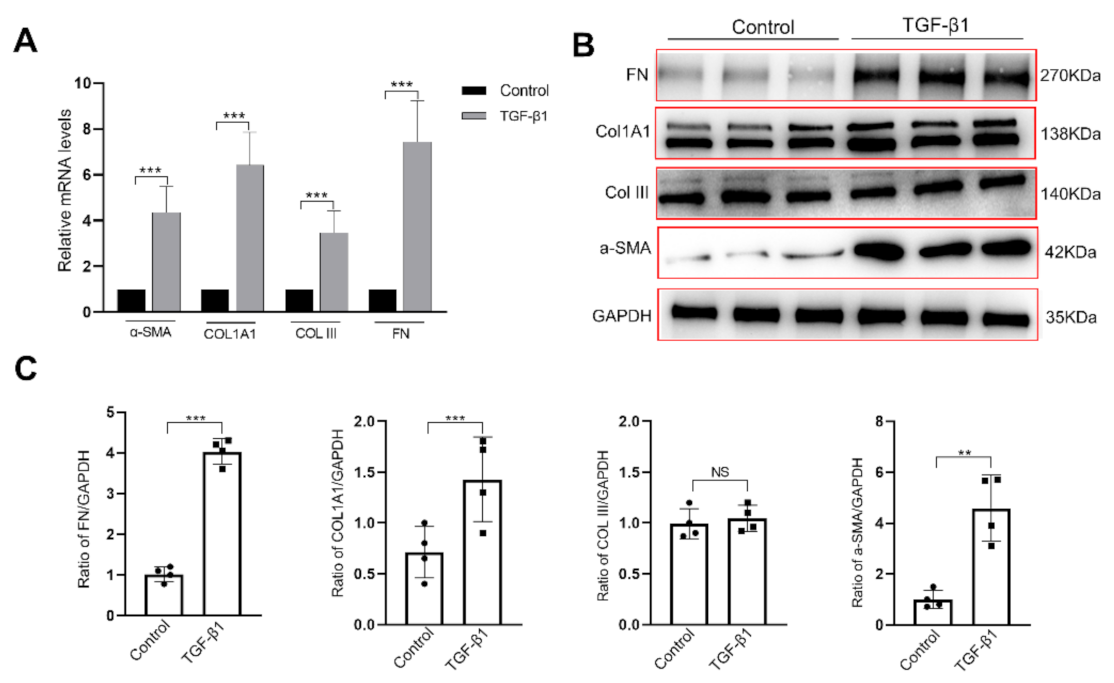
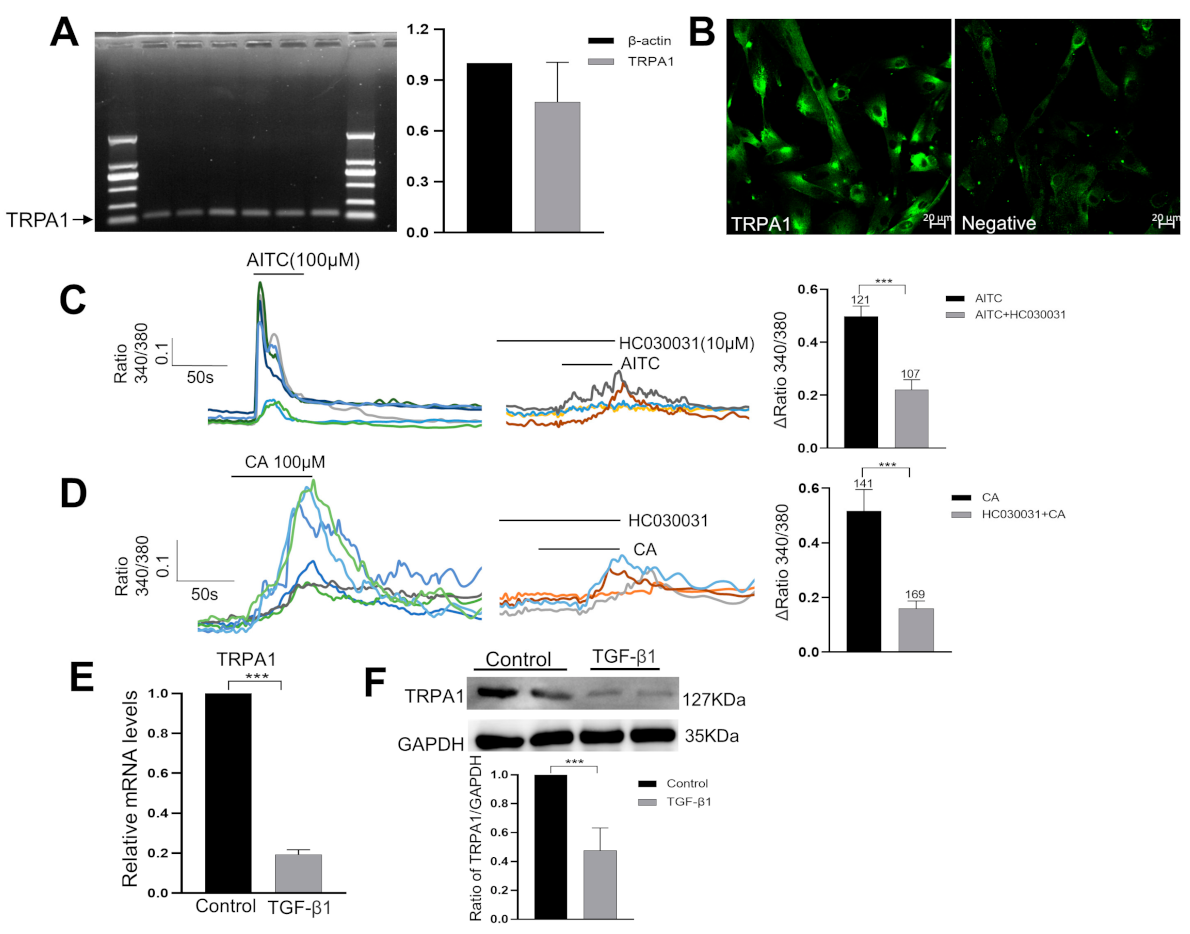

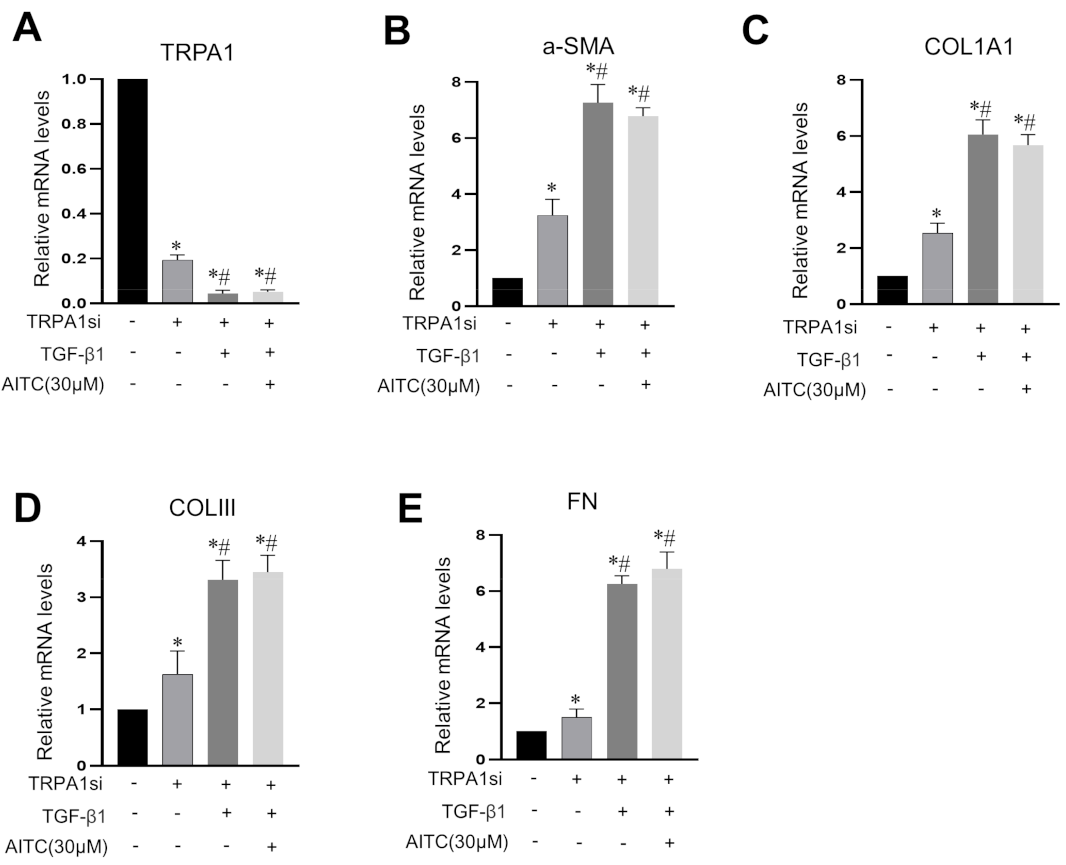
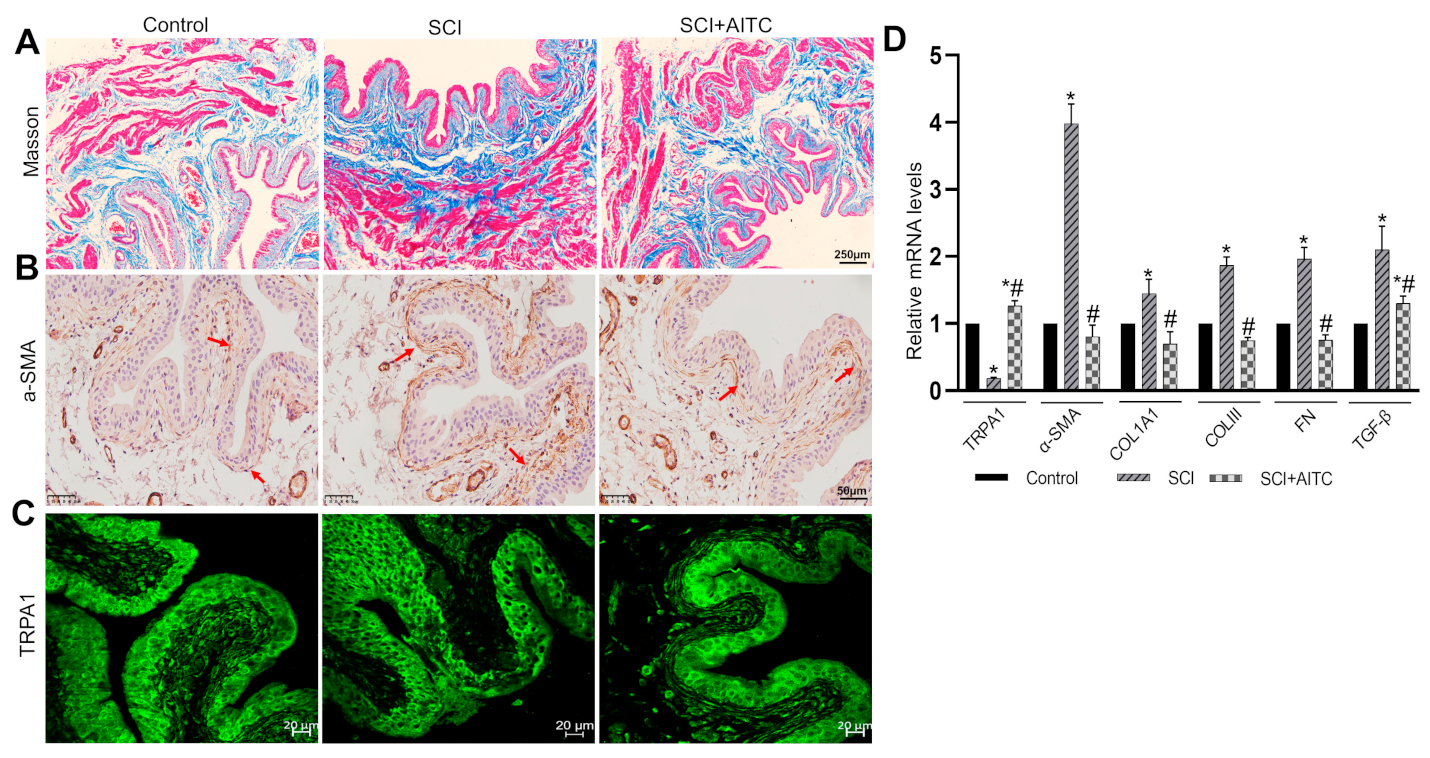
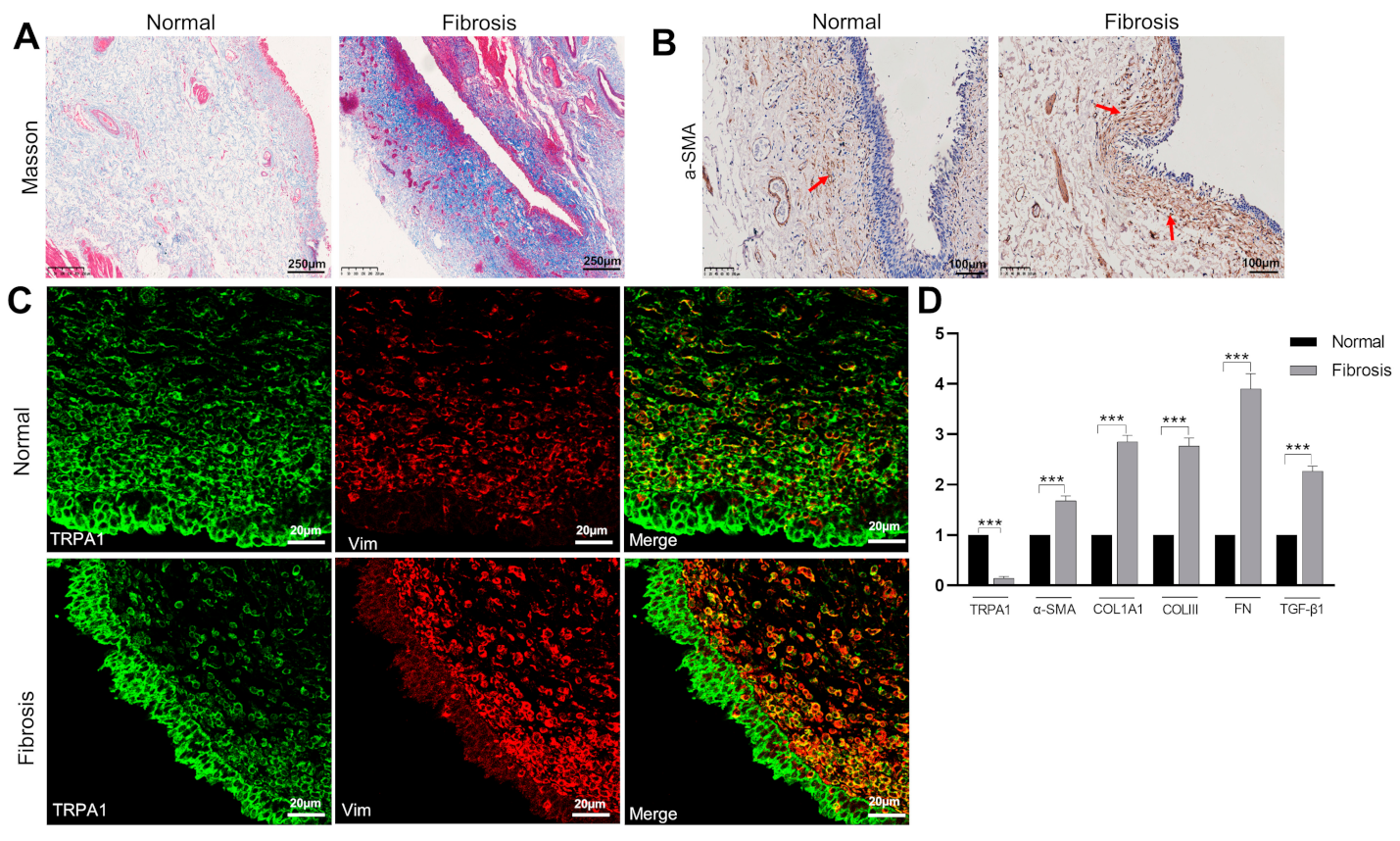
| Name | Sequence (5′–3′) | Length | Tm |
|---|---|---|---|
| Rat-ACTA2 F | ACCATCGGGAATGAACGCTT | 20 | 60 |
| Rat-ACTA2 R | CTGTCAGCAATGCCTGGGTA | 20 | 60 |
| Rat-COL1A1 F | CACTGCAAGAACAGCGTAGC | 20 | 60 |
| Rat-COL1A1 R | AAGTTCCGGTGTGACTCGTG | 20 | 60 |
| Rat-COLIII F | CAGCCTTCTACACCTGCTCC | 20 | 62 |
| Rat-COLIII R | GTCGCCATTTCTCCCAGGAA | 20 | 62 |
| Rat-TRPA1 F | CCATGGGTGGCTACACTCAG | 20 | 62 |
| Rat-TRPA1 R | TCAAAAGCATCGCAACAGCC | 20 | 62 |
| Rat-FN F | AAGCTACCATTCCAGGCCAC | 20 | 62 |
| Rat-FN R | GTCACTTCTTGGTGCCCGTA | 20 | 62 |
| Rat-β-actin F | CTCTGTGTGGATTGGTGGCT | 20 | 62 |
| Rat-β-actin R | CGCAGCTCAGTAACAGTCCG | 20 | 62 |
| Homo-ACTA2 F | ATGCCTCTGGACGCACAACT | 20 | 62 |
| Homo-ACTA2 R | CCCGGACAATCTCACGCTCA | 20 | 62 |
| Homo-TRPA1 F | CAGAAGACAAGTCCTGCCGA | 20 | 60 |
| Homo-TRPA1 R | TTGAGGGCTGTAAGCGGTTC | 20 | 60 |
| Homo-COL1A1 F | GCCAAGACGAAGACATCCCA | 20 | 60 |
| Homo-COL1A1 R | GGCAGTTCTTGGTCTCGTCA | 20 | 60 |
| Homo-COLIII F | CTGGTCCCGAAGGAGGAAAG | 20 | 59 |
| Homo-COLIII R | TAGGACCAGTAGGACCCCTTG | 20 | 59 |
| Homo-FN F | TGTGAACATCCCTGACCTGC | 20 | 60 |
| Homo-FN R | CAGGCGCTGTTGTTTGTGAA | 20 | 60 |
| Homo-TGFβ1 F | GCAACAATTCCTGGCGATACC | 21 | 60 |
| Homo- TGFβ1 R | ATTTCCCCTCCACGGCTCAA | 20 | 60 |
| Homo-β-Actin F | CATGTACGTTGCTATCCAGGC | 21 | 57.6 |
| Homo-β-Actin R | CTCCTTAATGTCACGCACGAT | 21 | 55.6 |
Disclaimer/Publisher’s Note: The statements, opinions and data contained in all publications are solely those of the individual author(s) and contributor(s) and not of MDPI and/or the editor(s). MDPI and/or the editor(s) disclaim responsibility for any injury to people or property resulting from any ideas, methods, instructions or products referred to in the content. |
© 2023 by the authors. Licensee MDPI, Basel, Switzerland. This article is an open access article distributed under the terms and conditions of the Creative Commons Attribution (CC BY) license (https://creativecommons.org/licenses/by/4.0/).
Share and Cite
Zhao, M.; Ding, N.; Wang, H.; Zu, S.; Liu, H.; Wen, J.; Liu, J.; Ge, N.; Wang, W.; Zhang, X. Activation of TRPA1 in Bladder Suburothelial Myofibroblasts Counteracts TGF-β1-Induced Fibrotic Changes. Int. J. Mol. Sci. 2023, 24, 9501. https://doi.org/10.3390/ijms24119501
Zhao M, Ding N, Wang H, Zu S, Liu H, Wen J, Liu J, Ge N, Wang W, Zhang X. Activation of TRPA1 in Bladder Suburothelial Myofibroblasts Counteracts TGF-β1-Induced Fibrotic Changes. International Journal of Molecular Sciences. 2023; 24(11):9501. https://doi.org/10.3390/ijms24119501
Chicago/Turabian StyleZhao, Mengmeng, Ning Ding, Haoyu Wang, Shulu Zu, Hanwen Liu, Jiliang Wen, Jiaxin Liu, Nan Ge, Wenzhen Wang, and Xiulin Zhang. 2023. "Activation of TRPA1 in Bladder Suburothelial Myofibroblasts Counteracts TGF-β1-Induced Fibrotic Changes" International Journal of Molecular Sciences 24, no. 11: 9501. https://doi.org/10.3390/ijms24119501
APA StyleZhao, M., Ding, N., Wang, H., Zu, S., Liu, H., Wen, J., Liu, J., Ge, N., Wang, W., & Zhang, X. (2023). Activation of TRPA1 in Bladder Suburothelial Myofibroblasts Counteracts TGF-β1-Induced Fibrotic Changes. International Journal of Molecular Sciences, 24(11), 9501. https://doi.org/10.3390/ijms24119501




